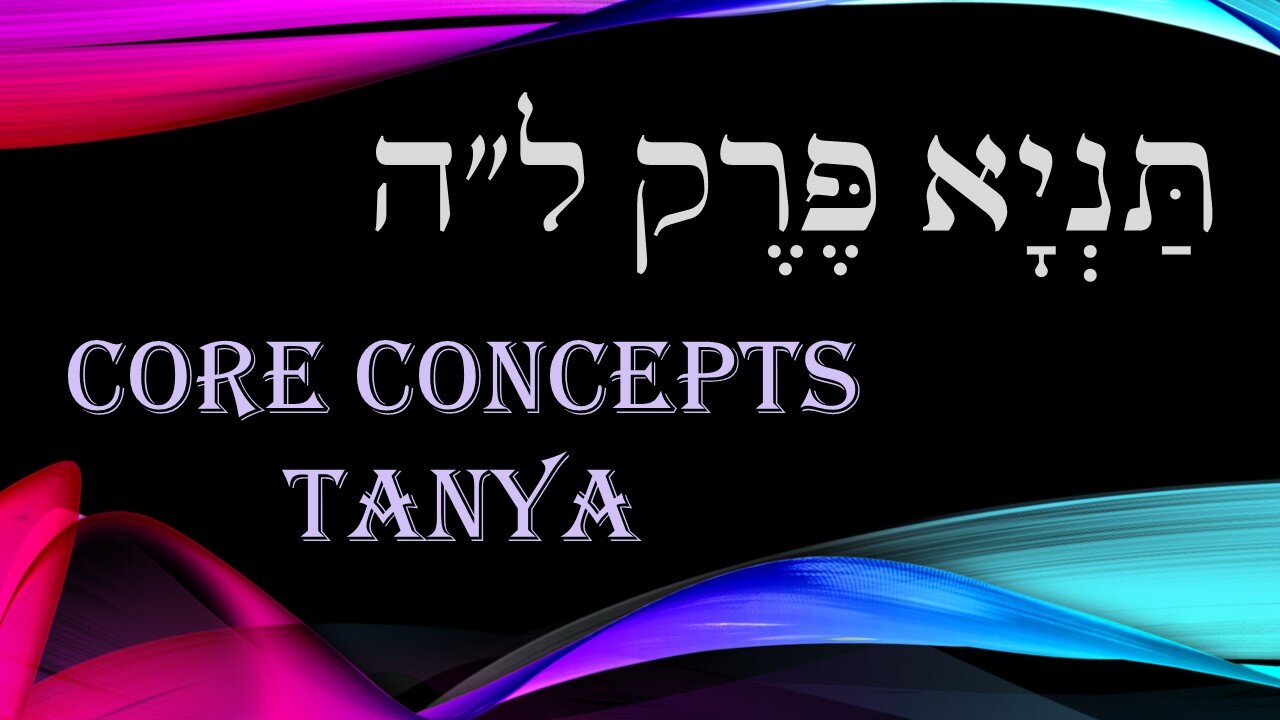Premium Only Content

Core Concepts Tanya: Chapter 35
Brief recap of Chapter 35:
1. Chapter 35 returns to the verse Tanya is based upon, "This thing is very near to you in your mouth and your heart to do it." The verse ends with the emphasis on "to do it," life in this world is about action, it's about Torah and Mitzvot. In short, the entire world, as in the entirety of creation, is a means to an end, it exists so man can study Torah and fulfill mitzvot.
2. The G-dly soul is perfect. It doesn't need to polished, fixed, or refined. So what's it doing in this world? What's it doing in a coarse, physical body daily battling base impulses and an animal soul? What comfort is there in knowing that we are daily engaged in a battle that we may very well never win? Were we created to go around in circles?
3. Not only is this battle not pointless, the Alter Rebbe reassures us, but it's the purpose of the entire creation! Our G-dly soul is pure and perfect, our animal soul is not. Ergo, the G-dly soul comes down into this world to perfect the animal soul in the body through Torah and Mitzvot. And it can only accomplish any of this while in the body, because the soul needs a vehicle through which to act in this physical world.
4. "A wise man's eyes are in his head." Well, where else are they supposed to be? The verse is saying that a wise man will know what is above his head...the light of the Divine. This light is like a flame, but to keep the flame burning we need to feed it. How?
5. The body is compared to a wick, coarse and physical. A wick by itself burns quick and smoky, but a wick with oil burns with a clean, steady, enduring flame. The light of Hashem that rests above us is the flame, the body is the wick, and the oil is the mitzvot that we do. Why can't the soul be the oil? Because just the fact that it's a soul makes it a separate entity, and Hashem does not dwell in a place of separateness. So, the mitzvot, Hashem's will and part of Him, are the oil absorbed by the flame through the wick. When the body engages in a mizvah, it becomes a vehicle for the Divine will, and thereby a place where Hashem can dwell.
6. How can the Divine Light be in so many places at once? The same way one sun streams through everyone’s windows! It's the same sun, as in the same light source, even though it manifests differently according to the object receiving it. The G-dly soul receives it one way, the body another, the animal soul a third. Think of windows in different shapes and sizes, some with curtains and shades, some stained glass or tinted, the same sun streams through all of them, but the light can look different on the other side.
7. From the three soul garments, thought, speech, and action, thought and speech are considered more internal, and thereby experience revelation on a more internal level, a level with greatest impact on the G-dly soul. This includes such things as studying Torah and praying. Action however can only be achieved on something external, as in something outside the body, which is when the Divine Light rests on the body/animal soul.
8. The G-dly soul is spiritual and has no matter. The body is entirely physical. The animal soul is the intermediary, as its part holy, being a soul, and part physical, and its based in the blood of a person. (Remember the left side of the heart...) The G-dly soul is the motivating force for the mitzvot, but the animal soul/body actually fulfills them, thereby elevating them and uniting with the Divine.
9. Returning to external vs internal will from previous chapters, external will is Hashem's will expressed in creation, internal will is Hashem's will expressed in mitzvot. The created world is necessary for the fulfillment of mitzvot, and when we do a mitzvah, we reveal G-dliness in this world. When we keep doing mitzvot, we will come to the point when Hashem's will is manifested throughout creation and the entire world will be illuminated with the light of the Divine.
-
 4:39:57
4:39:57
CassaiyanGaming
9 hours agoOpening Dragon Ball Z Collectible Cards | Saturday at 8pm central
5.06K -
 LIVE
LIVE
Cripiechuccles
8 hours ago😁💚💙SHATTERDAY WITH CRIPIE💚💙RUMLUV ACTIVATE👌
1,267 watching -
 2:12:18
2:12:18
Badlands Media
1 day agoDevolution Power Hour Ep. 361: Blackmail Machines, Controlled Chaos & the Trap Closing In
66.2K28 -
 16:52
16:52
DeVory Darkins
6 hours agoBREAKING: BOMBSHELL Update as LA Mayor dealt MAJOR BLOW from Tom Homan
34.7K142 -
 2:12:45
2:12:45
Tundra Tactical
5 hours ago $6.14 earned🛑 LIVE The Worlds Okayest Firearms Live Stream
21.3K1 -
 33:40
33:40
The Connect: With Johnny Mitchell
8 hours ago $7.04 earnedVisiting The Most DANGEROUS Hoods Of New York City With A Former Crack Kingpin | The Connect
35.2K1 -
 4:45:52
4:45:52
BubbaSZN
6 hours ago🔴 LIVE - NEW FORTNITE CHAPTER 6 SEASON 3 UPDATE
21.7K2 -
 3:11:36
3:11:36
BlackDiamondGunsandGear
5 hours ago🔴 After Hours Armory LIVE SHOW / TN Tactical
29.7K1 -
 3:14:56
3:14:56
megimu32
6 hours agoOFF THE SUBJECT: FAFO - Bodycam Chaos + Fortnite Mayhem
25.7K12 -
 3:10:28
3:10:28
DLDAfterDark
5 hours ago $1.36 earnedDLD Live! BDGG Josh - TN Tactical - The After Hours Armory
23.4K1